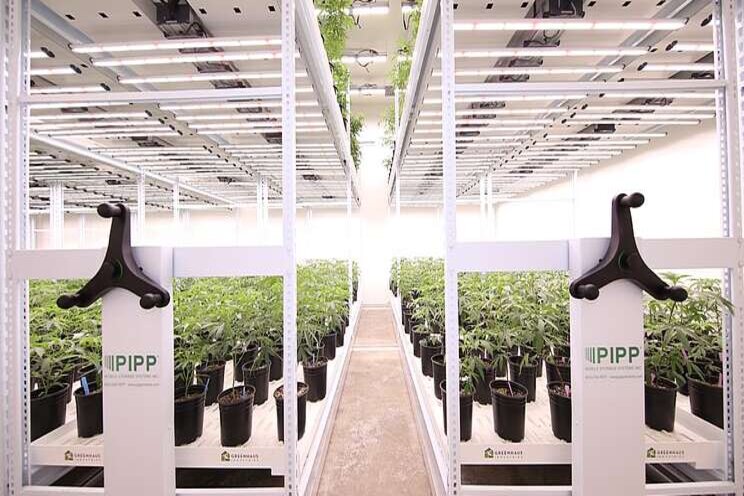Webinar: How to make vertical work for you
Added on 24 March 2021

In a recent webinar called Designing Your Own Vertical Farm, expert growers and system provider consultants from Pipp Horticulture, Vertical Air Solutions, and Fluence provided valuable insights into the realities of working in a vertical cannabis grow.

Fog City Farms in California is an innovator at the forefront of testing and applying vertical farming technologies to create a productive growing environment in one of the most expensive real estate states. Photo courtesy of Pipp Mobile Storage Systems Inc.
Designed for the Purpose of Growing
One of the most important factors in going with a vertical grow room is ensuring the facility is designed to maximize the available cubic space in the room while still providing an optimal environment for plant production. This means every aspect of the facility has been designed with climate, plant production space, workflow, sanitation, hygiene, and quality control in mind. While greenhouse and indoor growers in the controlled agriculture industry have spent decades perfecting their technique to optimize efficiencies, vertical farming at scale is a relatively new practice for commercial growers. Pioneers and manufacturers in the space have purposefully designed and built equipment to ensure it can perform well and not create unforeseen problems.
The webinar featured several leaders in the growing vertical farming segment who each brought their perspective on planning and equipment selection to consider when designing a vertical farm. From lighting and racking to the proper air flow, each piece of equipment plays an integral role in growers' success or failures when growing at scale. When planning your vertical farm, it is imperative to select vendors who can effectively communicate and collaborate to ensure your facility is designed properly to achieve your cultivation and business goals
The experts in this webinar identified common problems that can occur when designing and planning a vertical farm. Growers and facility planners who are considering a vertical farm should be familiar with these common problems to avoid potential setbacks and ensure they are discussing proper facility design. For example, in a vertical farm, racks, trays, railings, and light fixtures are all possible obstacles to the flow of inputs and outputs throughout the room. If a tray is not designed to accommodate significant plant density, you may end up with drainage issues. The structural components of a racking system or light fixture need to be thought of as barriers that can potentially impede airflow through the plant canopy. In vertical farms, microclimates are more likely to appear if airflow, VPD, light intensity, and other environmental factors are not designed with a vertical farm in mind. Below is a list of common problems that could occur in multi-layer plant production. If you are considering a vertical farm for cannabis cultivation, tune into the on-demand webinar here to learn from the experts!
Identifying Common Problems
Growing vertically can often present unforeseen issues that can become problematic if you do not find the root cause. The panelists identified a few key issues that tend to crop up, and some of the most common reasons these issues appear:
ˇ Photo-bleaching - High-intensity lighting needs to be introduced in small increments so as not to damage the chlorophyll in the leaves. Fluence recommends slowly increasing light intensity as your plant develops to ensure the success of healthy plant development and harvest
ˇ Microclimates - Lack of horizontal airflow can cause humidity and transpiration issues that will stress your plants and make it easier for pests to gain a foothold. Vertical Air Solutions recommends ensuring airflow is distributed at multiple points throughout the canopy to minimize the effects of microclimates.
ˇ Light uniformity - An advantage of using close proximity lighting in a vertical rack is the ability to ensure every plant receives high-intensity light throughout each layer of its canopy. However, when growing in proximity, it is important to understand light uniformity on your crops. Be sure to work with your lighting and racking to provider to visualize the anticipated light levels throughout the canopy as modeled in the racking system. If these calculations are done independently you run the risk of inaccurate light consistency on your plant canopy.
ˇ Sanitation - Creating the proper amount of spacing between racks to ensure that each plant can be reached, and the workflow is efficient is key in maintaining sanitation standards. One trick is to use a bio-foamer so your staff can see what has just been cleaned. But using mobile racks designed to be moved so every inch of the grow room can be maintained and adjusted is another way to ensure you are discovering and properly addressing microclimates in a timely manner.
ˇ Equipment integration - The main value of multi-layer farming is maximizing your cubic space of plant production. With this, it is important to select equipment that has seamless integration. For example, your lighting selection should have hardware that can fit into your racking, and your HVAC system should be installed to ensure consistent airflow. By selecting manufactures that integrate well with each other, you will achieve an optimal growing environment that maximizes production and minimizes any issues that could arise.
ˇ Know your regulations - States vary in their plant production facility space regulations. If a state considered your building floor space as part of the plant production portion of your facility, consider adding a second or third layer to produce more product. There are creative ways to meet your state's requirements and produce the most our of your space constraints.
Click here to read more.
Photo Courtesy of Fluence by OSRAM
Source: Fliuence By OSRAM
More news















